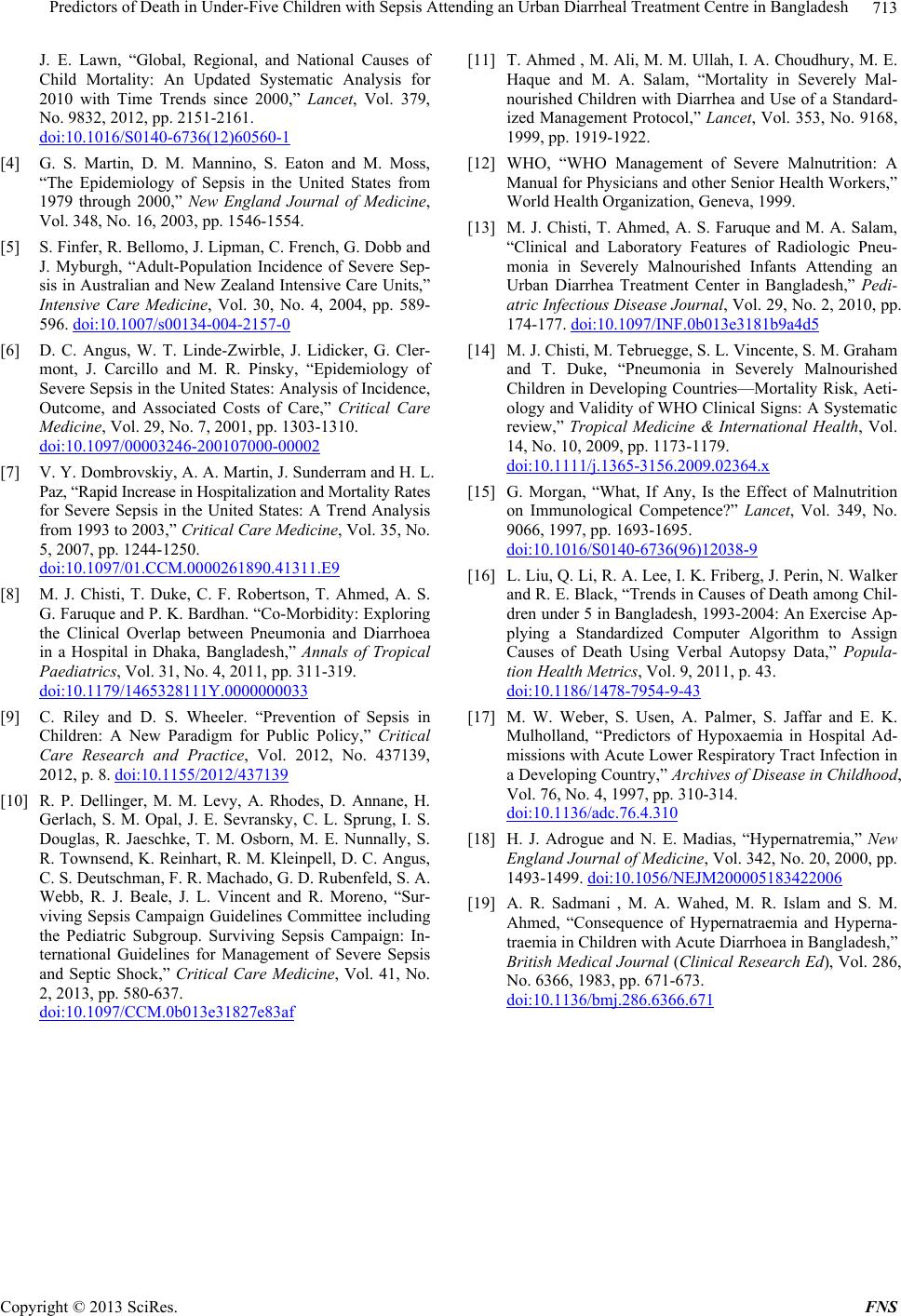
Predictors of Death in Under-Five Children with Sepsis Attending an Urban Diarrheal Treatment Centre in Bangladesh 713
J. E. Lawn, “Global, Regional, and National Causes of
Child Mortality: An Updated Systematic Analysis for
2010 with Time Trends since 2000,” Lancet, Vol. 379,
No. 9832, 2012, pp. 2151-2161.
doi:10.1016/S0140-6736(12)60560-1
[4] G. S. Martin, D. M. Mannino, S. Eaton and M. Moss,
“The Epidemiology of Sepsis in the United States from
1979 through 2000,” New England Journal of Medicine,
Vol. 348, No. 16, 2003, pp. 1546-1554.
[5] S. Finfer, R. Bellomo, J. Lipman, C. French, G. Dobb and
J. Myburgh, “Adult-Population Incidence of Severe Sep-
sis in Australian and New Zealand Intensive Care Units,”
Intensive Care Medicine, Vol. 30, No. 4, 2004, pp. 589-
596. doi:10.1007/s00134-004-2157-0
[6] D. C. Angus, W. T. Linde-Zwirble, J. Lidicker, G. Cler-
mont, J. Carcillo and M. R. Pinsky, “Epidemiology of
Severe Sepsis in the United States: Analysis of Incidence,
Outcome, and Associated Costs of Care,” Critical Care
Medicine, Vol. 29, No. 7, 2001, pp. 1303-1310.
doi:10.1097/00003246-200107000-00002
[7] V. Y. Dombrovskiy, A. A. Martin, J. Sunderram and H. L.
Paz, “Rapid Increase in Hospitalization and Mortality Rates
for Severe Sepsis in the United States: A Trend Analysis
from 1993 to 2003,” Critical Care Medicine, Vol. 35, No.
5, 2007, pp. 1244-1250.
doi:10.1097/01.CCM.0000261890.41311.E9
[8] M. J. Chisti, T. Duke, C. F. Robertson, T. Ahmed, A. S.
G. Faruque and P. K. Bardhan. “Co-Morbidity: Exploring
the Clinical Overlap between Pneumonia and Diarrhoea
in a Hospital in Dhaka, Bangladesh,” Annals of Tropical
Paediatrics, Vol. 31, No. 4, 2011, pp. 311-319.
doi:10.1179/1465328111Y.0000000033
[9] C. Riley and D. S. Wheeler. “Prevention of Sepsis in
Children: A New Paradigm for Public Policy,” Critical
Care Research and Practice, Vol. 2012, No. 437139,
2012, p. 8. doi:10.1155/2012/437139
[10] R. P. Dellinger, M. M. Levy, A. Rhodes, D. Annane, H.
Gerlach, S. M. Opal, J. E. Sevransky, C. L. Sprung, I. S.
Douglas, R. Jaeschke, T. M. Osborn, M. E. Nunnally, S.
R. Townsend, K. Reinhart, R. M. Kleinpell, D. C. Angus,
C. S. Deutschman, F. R. Machado, G. D. Rubenfeld, S. A.
Webb, R. J. Beale, J. L. Vincent and R. Moreno, “Sur-
viving Sepsis Campaign Guidelines Committee including
the Pediatric Subgroup. Surviving Sepsis Campaign: In-
ternational Guidelines for Management of Severe Sepsis
and Septic Shock,” Critical Care Medicine, Vol. 41, No.
2, 2013, pp. 580-637.
doi:10.1097/CCM.0b013e31827e83af
[11] T. Ahmed , M. Ali, M. M. Ullah, I. A. Choudhury, M. E.
Haque and M. A. Salam, “Mortality in Severely Mal-
nourished Children with Diarrhea and Use of a Standard-
ized Management Protocol,” Lancet, Vol. 353, No. 9168,
1999, pp. 1919-1922.
[12] WHO, “WHO Management of Severe Malnutrition: A
Manual for Physicians and other Senior Health Workers,”
World Health Organization, Geneva, 1999.
[13] M. J. Chisti, T. Ahmed, A. S. Faruque and M. A. Salam,
“Clinical and Laboratory Features of Radiologic Pneu-
monia in Severely Malnourished Infants Attending an
Urban Diarrhea Treatment Center in Bangladesh,” Pedi-
atric Infectious Disease Journal, Vol. 29, No. 2, 2010, pp.
174-177. doi:10.1097/INF.0b013e3181b9a4d5
[14] M. J. Chisti, M. Tebruegge, S. L. Vincente, S. M. Graham
and T. Duke, “Pneumonia in Severely Malnourished
Children in Developing Countries—Mortality Risk, Aeti-
ology and Validity of WHO Clinical Signs: A Systematic
review,” Tropical Medicine & International Health, Vol.
14, No. 10, 2009, pp. 1173-1179.
doi:10.1111/j.1365-3156.2009.02364.x
[15] G. Morgan, “What, If Any, Is the Effect of Malnutrition
on Immunological Competence?” Lancet, Vol. 349, No.
9066, 1997, pp. 1693-1695.
doi:10.1016/S0140-6736(96)12038-9
[16] L. Liu, Q. Li, R. A. Lee, I. K. Friberg, J. Perin, N. Walker
and R. E. Black, “Trends in Causes of Death among Chil-
dren under 5 in Bangladesh, 1993-2004: An Exercise Ap-
plying a Standardized Computer Algorithm to Assign
Causes of Death Using Verbal Autopsy Data,” Popula-
tion Health Metrics, Vol. 9, 2011, p. 43.
doi:10.1186/1478-7954-9-43
[17] M. W. Weber, S. Usen, A. Palmer, S. Jaffar and E. K.
Mulholland, “Predictors of Hypoxaemia in Hospital Ad-
missions with Acute Lower Respiratory Tract Infection in
a Developing Country,” Archives of Disease in Childhood,
Vol. 76, No. 4, 1997, pp. 310-314.
doi:10.1136/adc.76.4.310
[18] H. J. Adrogue and N. E. Madias, “Hypernatremia,” New
England Journal of Medicine, Vol. 342, No. 20, 2000, pp.
1493-1499. doi:10.1056/NEJM200005183422006
[19] A. R. Sadmani , M. A. Wahed, M. R. Islam and S. M.
Ahmed, “Consequence of Hypernatraemia and Hyperna-
traemia in Children with Acute Diarrhoea in Bangladesh,”
British Medical Journal (Clinical Research Ed), Vol. 286,
No. 6366, 1983, pp. 671-673.
doi:10.1136/bmj.286.6366.671
Copyright © 2013 SciRes. FNS